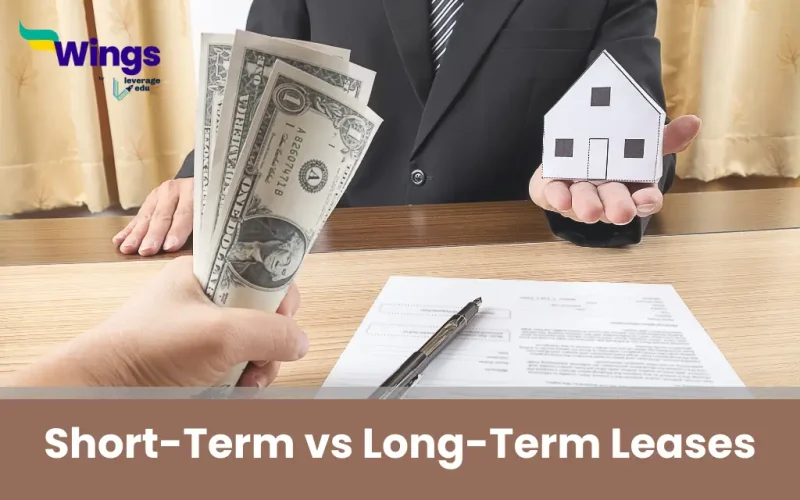Moving abroad for studies is exciting, but it comes with its challenges like finding the right accommodation to live in. The major decision while looking for housing comes with whether to go for a short-term lease or a long-term lease.
If you are also confused about these decisions, then this blog will be of great help to you. Here we will explore the short-term vs. long-term leases for international students and help you understand which one is best for you.
This Blog Includes:
What is a Short-Term Lease?

A short-term lease is a rental contract lasting less than six months. It’s ideal for international students on short courses, exchange programs, or internships. These leases offer more flexibility, allowing you to move easily, but usually come with higher rent. They’re perfect if your stay abroad is temporary or you’re unsure about long-term plans.
Pros:
- Greater flexibility
- Easier to relocate or change accommodation
- Ideal for short stays or unsure timelines
Cons:
- Higher monthly rent
- Fewer furnished options in some cities
- Limited availability during peak academic seasons
What is a Long-Term Lease?
A long-term lease typically lasts six months to a year or more. It suits international students enrolled in full-degree programs or research-based studies. These leases offer stability, lower monthly rent, and better chances of finding furnished options. However, they require a longer commitment and may include penalties if you break the contract early.
Pros:
- Lower rent per month
- More stability and better planning
- Higher chance of getting fully furnished places
Cons:
- Less flexibility if plans change
- Harder to break the lease without penalties
- Requires long-term commitment and upfront documents
Key Differences between Short-Term vs Long-Term Leases
When choosing between a short-term and a long-term lease, international students need to consider their course duration, flexibility, and budget. Each lease type has its pros and cons, and knowing the differences can help you make the right decision for your stay abroad.
| Feature | Short-Term Lease | Long-Term Lease |
| Duration | Less than 6 months | 6 months to 1 year+ |
| Flexibility | High | Low |
| Monthly Cost | Higher | Lower |
| Furnished Options | Less common | More common |
| Ideal For | Exchange students, internships | Degree programs, long stays |
Also Read:
- Culture Shock Examples in Japan: Things That Surprise International Student
- Importance of Student Accommodation in the Study Abroad
Factors to Consider Before Choosing a Lease Type

When it comes to short-term vs long-term leases for international students, the decision isn’t always easy. You need to consider your academic plans, lifestyle, and budget. Before signing anything, ask yourself the right questions mentioned above to understand which student accommodation suits you best.
- How long is your academic program?
If you’re studying abroad for just a semester, a short-term lease for students makes more sense. For full-degree courses, you’re better off locking in a long-term student accommodation option. The length of your course is one of the most important factors in deciding your lease type.
- Will you be switching cities or campuses?
Planning to move cities or switch campuses for internships or future semesters? Then go for flexible student housing options abroad, like short-term leases. A long-term lease might tie you down and cost more if you have to break it early.
- Do you need flexibility in case your visa or plans change?
Visa delays or last-minute changes are common. If that’s a possibility for you, a short-term lease for students gives you wiggle room. It’s less risky and won’t trap you in a long-term commitment if your plans fall through.
- What’s your monthly budget?
Short-term leases usually cost more per month, while long-term student accommodation offers better rates and value. If you’re looking for affordable student housing options abroad, a long-term lease might be kinder to your wallet, but only if you’re sure about staying for the entire period.
- Do you prefer a fixed place or want to explore?
Some students want to experience different neighbourhoods or live closer to campus facilities. In that case, go with a short-term lease and explore. But if you prefer stability and routine, long-term student accommodation will offer the peace of mind you’re after.
Popular Cities & Lease Trends for International Students

When exploring short-term vs long-term leases for international students, location plays a big role. Lease durations and prices vary by city. Some places offer flexible options, while others lean toward year-long contracts. Here’s a quick look at student-friendly cities and their common student accommodation lease types.
| City | Popular Lease Type | Typical Lease Duration | Avg. Rent (Monthly) | Student-Friendly Areas |
| London, UK | Long-term | 6–12 months | GBP 600 – GBP1,200 | Zone 2, Stratford, Camden |
| Toronto, Canada | Long-term with some short-term | 8–12 months | CAD 700 – CAD 1,200 | Scarborough, North York |
| Melbourne, AUS | Short & Long-term | 3–12 months | AUD 800 – AUD 1,400 | Carlton, Parkville, Brunswick |
| Berlin, Germany | Mostly Long-term | 6–12 months | EUR 400 – EUR 800 | Kreuzberg, Neukölln, Mitte |
| Boston, USA | Short-term options available | 3–12 months | USA 900 – USA 1,500 | Allston, Cambridge, Fenway |
| Amsterdam, NL | Short-term hard to find | 10–12 months | EUR 500 – EUR 1,000 | De Pijp, Oost, Zuidoost |
| Dublin, Ireland | Mix of short & long-term | 3–12 months | EUR 700 – EUR 1,200 | Rathmines, Drumcondra, City Centre |
Renting Tips for International Students
Navigating short-term vs long-term leases for international students can be tricky. With so many student housing options abroad, it’s easy to overlook key details. Whether you choose a short-term lease for students or long-term student accommodation, these smart tips will help you avoid stress and settle in smoothly.
1. Read the lease agreement carefully
Before signing, go through every clause of the lease. Understand the rules, duration, renewal terms, and financial commitments. This helps avoid disputes later, especially if you’re exploring student accommodation lease types in a new country.
2. Check cancellation or break clauses
Many international students face last-minute changes in visa or program duration. Make sure the lease has flexible cancellation terms or break clauses to suit your unpredictable academic timeline.
3. Look for student-specific housing platforms
Use websites or platforms built for international students. These usually list verified, affordable, and flexible student housing options abroad, making the rental process safer and easier.
4. Consider furnished apartments to avoid setup costs
Fully furnished rentals save you the hassle of buying furniture, especially for short-term leases for students. They’re ideal if you’re coming for just a semester or a language program.
5. Factor in utilities, deposits, and admin fees
Hidden costs can pile up. Always ask if utilities, internet, maintenance, and admin fees are included in the rent. It’s a key step in smart budgeting for both short-term and long-term student accommodation.
Pro Tip: Talk to seniors or join local student Facebook/WhatsApp groups. They often post verified listings and honest reviews on neighbourhoods, lease types, and safety.
Also Read:
- When to Apply for Student Accommodation: Best Timing and Tips
- Pros and Cons of Living in the USA for Students
Common Mistakes to Avoid When Signing a Lease

Even experienced renters can get it wrong. When moving to a new country, you need to avoid the basic mistakes as much as you can. Here’s what to avoid when choosing between short-term vs long-term leases for international students:
1. Not visiting (or virtually viewing) the place beforehand
Photos can be misleading. Always ask for a video tour or virtual walk-through. This prevents nasty surprises when you move in.
2. Forgetting to budget for hidden costs like utilities and Wi-Fi
Rent might look affordable at first glance, but extras like heating, electricity, and internet can bust your budget, especially in shared housing.
3. Not understanding local tenant rights
Each country has different rental laws. Learn your rights regarding deposits, eviction rules, and repair responsibilities to avoid being taken advantage of.
4. Skipping the fine print on deposits and penalties
Some landlords have strict clauses on refunds, damages, or late payments. Always check the refund process and keep receipts or a written record.
5. Ignoring neighbourhood safety and commute options
A cheap place far from campus or in an unsafe area can ruin your experience. Prioritise safety and public transport links over slightly lower rent.
Both short-term and long-term leases have their perks. If you’re on a short course, internship, or love flexibility, go short-term. But if you’re planning to stay put, a long-term lease offers stability and better value. However, understanding your academic plan, researching early, and reading the fine print will help you to make an informed decision.
Evaluate all study abroad options with Leverage Edu. Stay tuned with Leverage Live classes and realise your dream of studying abroad
FAQs
Long-term leases are usually cheaper per month, but short-term leases offer flexibility.
Only if your lease has a break clause or sublet option, always check the terms!
Yes, especially during peak intake months. Start your search early.
Most long-term leases require one. Short-term rentals may be more flexible.
Yes, but you might need to pay a higher deposit or use a guarantor service.
Student housing is easier to manage but often costlier. Private leases give more options.
Sometimes, especially in private rentals. It doesn’t hurt to ask!
Usually: passport, student visa, admission letter, and sometimes financial proof or a guarantor.
You may face penalties or legal issues; always extend or renew properly.
Agents help with legalities but charge fees. University housing offices can also assist for free.
 One app for all your study abroad needs
One app for all your study abroad needs















 60,000+ students trusted us with their dreams. Take the first step today!
60,000+ students trusted us with their dreams. Take the first step today!